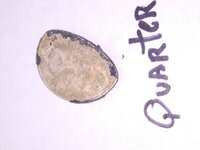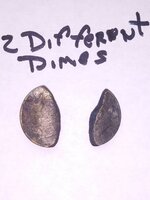LawrencetheMDer
Active member
This year, on 2 different hunts to the same beach, I found a total of 4 coins fragments; that is, one half of a coin that was cut in half. The half coins included a quarter, 2 dimes and a cent. It appears that the coins were cut in half with some type of metal sheers since the cut edges are not clean-cut but rather sheered off. I found the partial coins on a beach that also produces a large number of cremation tags, melted balls of gold (dental tooth fillings) and most recently a pair of gold caps. I guess cut in half coins may have something to do with burial??? Any other guesses?



